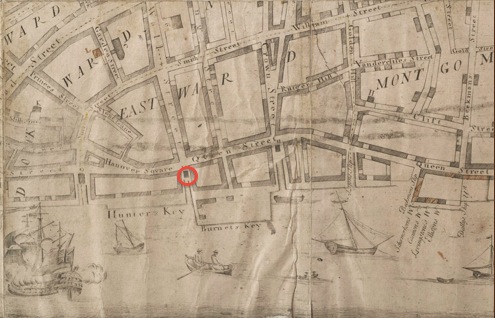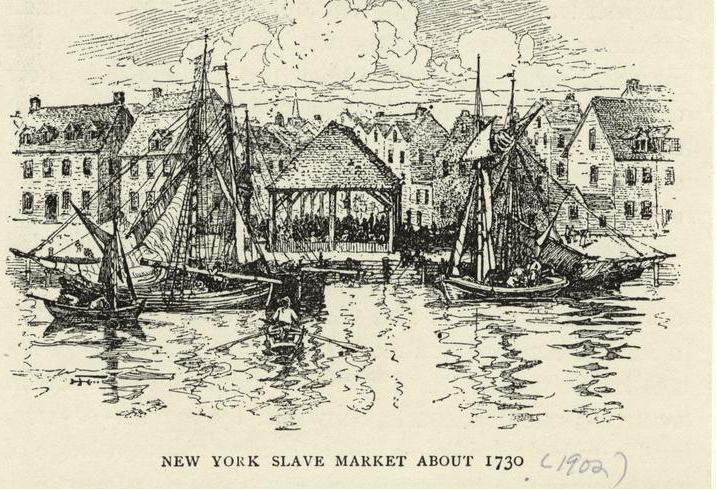Today is of course Martin Luther King Day. OWS observances included a gathering at the African Burial Ground in Manhattan, followed by a march to Wall Street, where there was a slave market, established in 1709. This was not simply a historical recovery but a reminder that the authority claimed by present day claims to visualize the social derives from the power of the slave-holder.
New York was not a marginal place in the history of slavery:
the city contained the largest absolute number of enslaved Africans of any English colonial settlement except Charleston, South Carolina, and held the largest proportion of enslaved Africans of any northern settlement. By the first decade of the 1700’s, forty percent of New York’s households contained at least one enslaved African.
Its slave market was an unimpressive building designed for the rapid circulation of human property.
It is routinely claimed that such histories can safely be consigned to the past. There are three ways in which such claims are invalid.
1. Slavery and Capital
The Caribbean historian and decolonial politician Eric Williams established a key link between capitalism and slavery in his 1944 classic text of that name. In his recent magnum opus Debt, the OWS theorist and occupier David Graeber has shown that debt and money owe their very existence to slavery: “Money, then, begins, as [Phillipe] Rospabé himself puts it ‘as a substitute for life.’ One might call it the recognition of a life-debt” (133). Thus so-called “blood-money” is exactly the same as money that is used to arrange a marriage: money in exchange for a life. The “slave” is the person utterly alienated from life, so that to all intents and purposes they are socially dead.
2. “The New Jim Crow”
This is the name given by legal scholar Michelle Alexander to the extraordinary racialized disparities in the US “justice” system. One in three young African American men are in some way involved in this system. In Washington DC, 3 out of 4 such men will be imprisoned or otherwise subject to penalty, part of the 2 million in the current prison system. Such figures exceed even the ratios generated by the apartheid system in South Africa. As drug use is about the same in white and black communities, the cause is not outlandish substance abuse by African Americans. Alexander shows that:
A huge percentage of [African Americans] are not free to move up at all. It is not that they lack opportunity, attend poor schools, or are plagued by poverty. They are barred by law from doing so…To put the matter starkly: The current system if control permanently locks a huge percentage of the African American community out of the mainstream society and economy. The system operates through our criminal justice institutions but it functions more like a caste system than a system of crime control. (13)
That is to say, the possibility of democracy is permanently impaired by a caste system, itself the direct descendant of slavery, as W.E.B. Du Bois and Angela Y. Davis have shown. Any direct democracy must first be an abolition democracy, a democracy that refuses the caste system at a minimum and, Davis would argue, the prison-industrial complex itself.
3. Visuality and Slavery
Visuality is a means of suturing authority to power. Power can be reduced to the means to compel people to act or not act by force. Usually, however, people respect the authority of the state, even when they disagree with it. Authority is a separate category to power. It is derived from the Latin term auctor, meaning the head of a family. As head of this family, the auctor had control over the possible purchases of land, animals and slaves. His patriarchy depended on this power, just as his financial empowerment reinforced his patriarchy. This is why any questioning of authority sooner rather than later generates questions of gender and (in countries where Africans were enslaved) racialized difference.
This analysis still begs the question of why the auctor was held to have such authority. In the Roman historian Livy, authority is distinguished from power (imperium) by the ability to interpret signs. This ability to discern meaning in both the medium and the message generates visuality’s aura of authority. When it is further invested with power, that ability becomes the ability to designate who should serve and who should rule.
The rulers in these histories are the named, those whose genealogies are held to count. Those without part, who do not count, are the anonymous, as incapable of visualizing the social as they are of being themselves visualized. Abolition democracy begins with the history of the anonymous, a project for this week’s posts.


